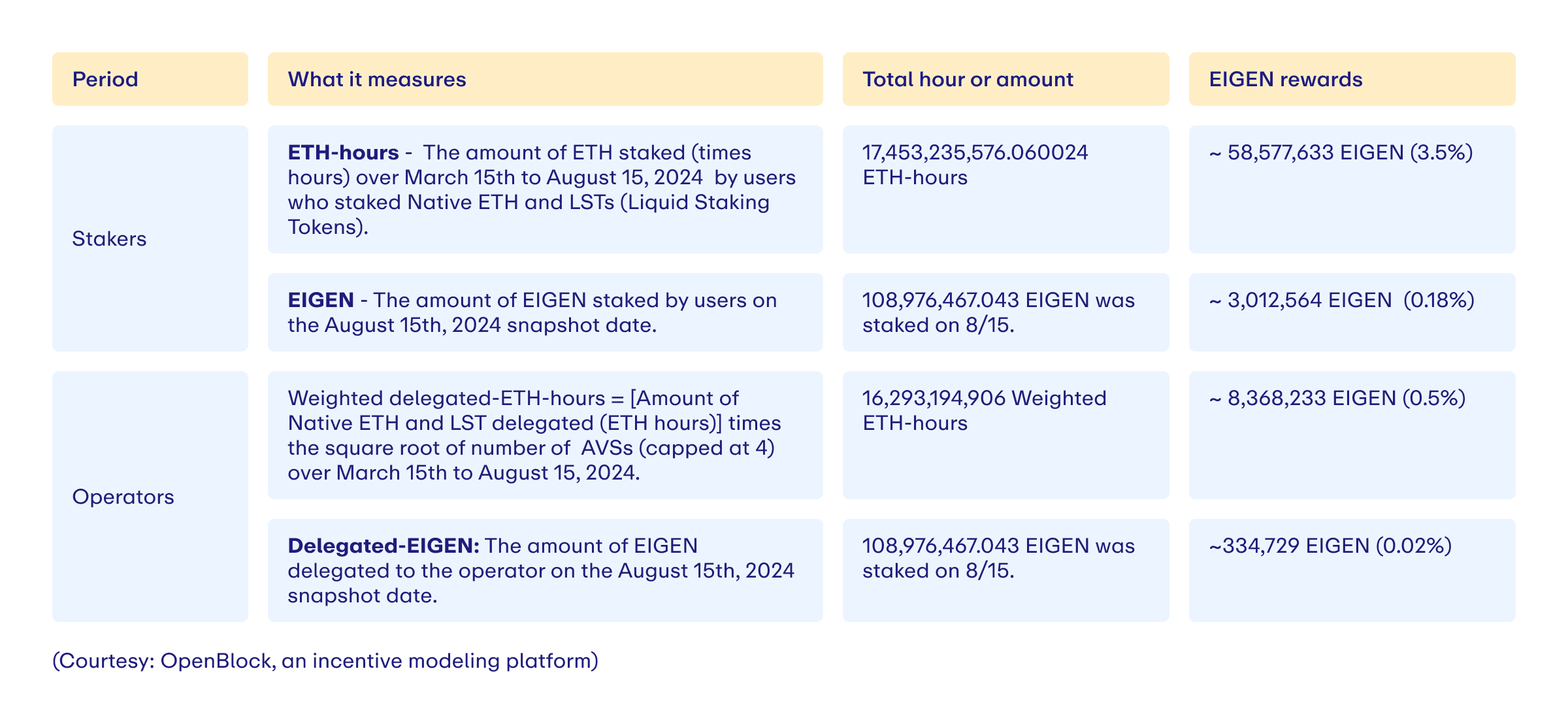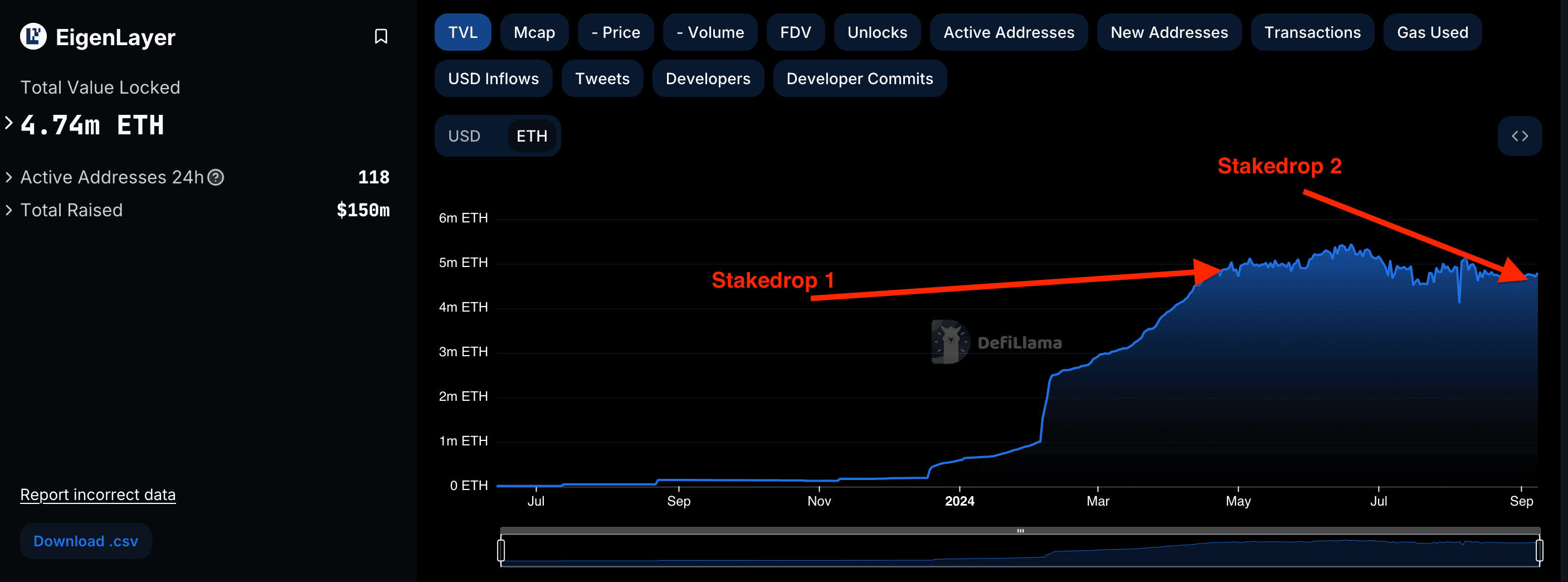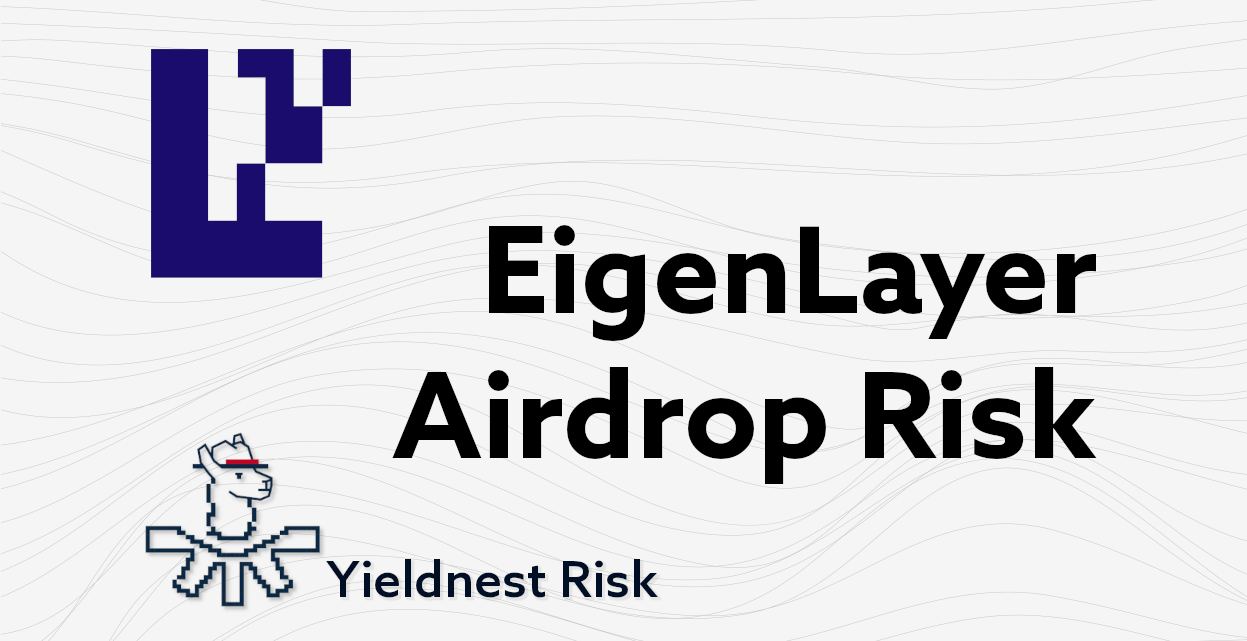Sep 16, 2024
Useful Links
Introduction
The EigenLayer airdrop program involves the distribution of its native token, EIGEN, to users who meet specific eligibility criteria, primarily based on their participation in the restaking process. The airdrop had faced criticism for its distribution plan, particularly regarding the exclusion of certain users and the perceived inadequacy of rewards compared to expectations. Following backlash, EigenLayer announced additional distributions of EIGEN tokens to address some of these concerns, indicating a commitment to refining its airdrop strategy and deepening user engagement within the ecosystem.
The total supply of the EIGEN token is set at 1.67 billion, with a significant portion allocated to the community—45% of the total supply. This includes 15% for stakedrops, 15% for community initiatives, and another 15% for ecosystem development, which aims to foster a robust community around the protocol.
Season 1 Overview
The first season of the EigenLayer airdrop, known as the "Stakedrop," was launched on April 29, 2024. This initiative aimed to distribute a total of approximately 113 million EIGEN tokens (15% of the initial supply) to participants who staked their assets. The Stakedrop was designed to reward early adopters and those who actively engaged with the EigenLayer protocol:
Users who directly restaked ETH or Liquid Staking Tokens (LSTs) on EigenLayer before March 15, 2024;
Users who created EigenPods or staked LSTs directly via the EigenLayer platform;
Most users who interacted with Liquid Restaking Tokens (LRTs) before March 15, 2024;
Certain Goerli testnet stakers and operators.
To ease the tension stemming from the complaints about the initial distribution, EigenLayer announced an additional allocation of approximately 28 million EIGEN tokens to be distributed among the claimants of Season 1.
The first phase of the Stakedrop was followed by a second phase, which opened on June 19, 2024, further expanding the distribution of EIGEN tokens to eligible participants. This additionally defined users who interacted with EigenLayer through more complex channels, i.e. DeFi protocols like Kelp, Pendle, and Equilibrium, before March 15, 2024.
The claim window for Phase 2 was open until September 7, 2024. All participants from Season 1, including those in Phase 2, will receive a bonus of 100 EIGEN tokens.

Source: Eigen Foundation
Season 2 Overview
Season 2 of the EigenLayer airdrop is currently underway, with details just released. This stakedrop follows a roughly similar model to Season 1, though this season has more granularity in its decision-making. 70M EIGEN are distributed to Stakers and Operators along with their "ETH-hours" contributed in addition to how much EIGEN they have staked. Community members such as "open source contributors, early advocates, and contributors who have supported EigenLayer since its inception" will receive 6M EIGEN and various ecosystem partners including "AVSs, LRTs, Rollups, RaaS, and other key contributors to the EigenLayer ecosystem" will receive 10M EIGEN.

Source: Eigen Founation
Differences between the two seasons
The key differentiation lies in the eligibility criteria, distribution percentages, and the platforms involved in each stage. Season 1 emphasizes direct participation in Eigenlayer and a subset of associated DeFi protocols, while Season 2 has broadened its scope to include more diverse user engagement and feedback-driven adjustments.
Risks for Season 1 Airdrop
Participation requirements and potential exclusions
An important aspect of the EigenLayer airdrop is the potential exclusion of certain user groups. For instance, there has been considerable backlash regarding the decision to restrict participants from the U.S. and Canada from the upcoming airdrop, which contributed to over 12,000 queued withdrawals shortly after the airdrop was completed.
The Airdrop Terms and Conditions specify prohibited jurisdictions as sanctioned jurisdictions, as well as jurisdictions subject to heightened sanctions risks identified or enforced by specific countries, governments, or international authorities. Additionally, these include jurisdictions otherwise considered high risk concerning the Airdrop. It is important to note that the Eigen Foundation can amend these prohibited jurisdictions without prior notice.
There is evidence indicating Eigen Labs contributors themselves (including even their General Counsel) have nonetheless been subverting these potential exclusions. This draws attention to the ineffectiveness of the practice.
Token distribution model
As a general principle, Season 1 rewards have been distributed based on four key factors:
length of time users have been staking,
the amount of their stake,
how early the user started staking compared to others and
whether they maintained their stake over time.
The same criteria as Phase 1 (Duration, Amount, Earliness, and Loyalty) are applied in Phase 2, and there is no penalty for being in Phase 2 versus Phase 1. A potential differentiating factor is the allocation role assigned to LRT protocols that are expected to assist in determining the distribution based on users’ interactions with the protocol.
The reliance on LRT projects to determine fair distribution introduces risks. Each project’s methodology might differ, potentially leading to inconsistencies or perceived unfairness among users.
Additionally, despite conducting sybil analysis to ensure fairness, there is always a risk that some users may have manipulated the system by creating multiple accounts to receive a disproportionate amount of the token distribution.
Unclaimed tokens from both phases are allocated for future distributions. If significant amounts remain unclaimed, this could lead to centralization or affect EIGEN’s market dynamics once redistributed.
Lockup implications
Participants should be aware of the terms and conditions associated with the airdrop, as these may include stipulations about token lockup periods and non-transferability of the tokens received.
A one-year lock-up period will be enforced for specific EIGEN holders, such as Eigen Foundation service providers and recipients of EIGEN allocations from Eigen Labs, Inc. All tokens allocated to investors and core contributors will be subject to a full lock-up period from the date of initial transferability. Following this period, a monthly unlocking of 4% will commence for EIGEN allocated to investors and core contributors. Consequently, the complete unlocking of EIGEN held by investors and core contributors will not be realized until 3 years after the tokens first become transferable.
As of now, EIGEN is non-transferable. The transferability of the token is expected to be activated after achieving key product and decentralization milestones. These milestones are targeted to be completed by September 30th, 2024.
Risks for Season 2 Airdrop
Eligibility criteria
For Season 2, there has been an expanded criteria that shifted to include a broader range of DeFi users, benefiting those who have engaged with other projects or protocols within the restaking field. This may result in a more inclusive distribution but also raises the risk of alienating long-time supporters who may not meet the new requirements.
Potential for reduced rewards
With a spiking user base, the distribution of rewards has become more diluted. A dilution can occur if the total number of eligible participants increases significantly, thereby spreading the rewards across a larger base. Additionally, the introduction of new features or changes in the reward structure could also impact the overall distribution strategy, potentially leading to lower individual rewards for participants in Season 2. This reduces individual incentives and potentially undermines willingness to further participate in the campaign.
Impact of increased participation
In Season 2, participants who support more AVSs will likely receive greater EIGEN programmatic emissions. This incentivization model encourages users to actively engage with the platform, thereby increasing the overall participation rate.
While a larger pool of stakers can enhance security, it also raises concerns about centralization and the risk of network failure due to the challenges of managing a greater number of nodes and operators. Moreover, the opportunity costs for participants can be significant. With an influx of users, competition for rewards may intensify, potentially diminishing returns for individual stakers.
Economic Risks
Token value fluctuations
The cryptocurrency market is notorious for its volatility, and airdropped tokens are no exception. EIGEN tokens are likely to experience significant price fluctuations, especially in the immediate aftermath of the airdrop. Historical data from similar airdrops suggests that prices can swing wildly in the first few days or weeks post-distribution, presenting both opportunities and risks for token holders.

Source: Coingecko | Date: 03.09.2024

Source: Coingecko | Date: 03.09.2024
Potential for token dumping post-airdrop
The phenomenon of "dumping" – where a large number of recipients sell their tokens immediately after receiving them – is a common occurrence in many airdrops. This sudden increase in selling pressure can lead to a sharp decline in token price, potentially harming both short-term traders and long-term believers in the project.
Even with vesting mechanisms in place for core contributors and investors, the risk of dumping remains. Large token holders, often referred to as "whales," can have a disproportionate impact on the market if they decide to sell. Additionally, the psychology of "free money" associated with airdrops can motivate many participants to sell quickly to secure profits, regardless of their belief in EigenLayer's long-term potential.
To counter this, EIGEN staking has been implemented. It allows tokenholders to secure Actively Validated Services (AVSs) on EigenLayer. In the upcoming stakedrop seasons, staked EIGEN will be taken into account and will have the opportunity to earn fees from AVSs. Importantly, EIGEN staked by investors or core contributors will not impact the rewards, as their stakes will not be factored into future stakedrop rewards.
Impact on TVL

Source: DeFiLlama -- TVL is denominated in ETH for additional granularity
These airdrop campaigns have not massively increased nor decreased TVL. As demonstrated by the above image, stakedrop 1 roughly retained protocol TVL and stakedrop 2 saw no immediate large decrease in TVL. This is very impressive given EigenLayer's position in the TVL leaderboard at #3. It is indicative of a largely satisfied ecosystem of stakers as should there be better opportunities elsewhere they would have pursued them. EigenLayer still presents an attractive place to farm ETH in large size that other incentive programs may not be able to accommodate.
This is contrary to what may been expected as despite a large number of withdrawals being queued, significant capital flight was not seen.
Many other protocols see large TVL spikes in the lead-up to airdrop announcements followed by prolonged periods of TVL downtrend. The fact that so far this is not the case is further evidence of a sufficiently attractive airdrop strategy.
Regulatory Risks
Compliance with securities laws
The EigenLayer airdrop has raised significant concerns regarding compliance with U.S. securities laws. The primary issue revolves around whether airdropped tokens are classified as securities under U.S. law, particularly in light of the SEC's stringent regulations.
Implementation of geoblocking measures to prevent U.S. users from claiming their EIGEN tokens, as a strategy aimed at mitigating legal risks associated with securities laws compliance, has been criticized by some as an ineffective response to what they perceive as the SEC's overreach in regulating the crypto space.
However, the lack of clarity in the law means that many projects, including EigenLayer, are erring on the side of caution. Geoblocking is currently seen as a working model to mitigate the legal risk that comes with a lot of unknowns.
Tax implications for participants
The tax implications for participants in the EigenLayer airdrop can be quite significant and vary depending on jurisdiction. Generally, receiving airdropped tokens is considered taxable income, and participants may need to report the fair market value of the tokens at the time they are received. In some cases, if the airdropped tokens are not immediately usable or accessible, they may not be taxable until the recipient can exercise control over them.
As per the Airdrop Terms and Conditions, it is understood that the user assumes full responsibility for any taxes associated with their participation in the airdrop. It is also acknowledged that they receive tokens through the airdrop for free, with the exception of potential gas fees or taxes payable to third parties. Additionally, users are advised to consider the potential tax implications of digital assets and are strongly encouraged to seek advice from a qualified tax advisor regarding the tax treatment of airdropped EIGEN in their respective jurisdiction.
Potential for future regulatory crackdowns
Crypto airdrops have become a popular method for distributing tokens, but their regulatory status is complex and varies by jurisdiction. In the United States, the Internal Revenue Service (IRS) treats airdrops as taxable events. Additionally, the U.S. Securities and Exchange Commission (SEC) has indicated that airdrops may be classified as securities offerings, depending on the circumstances surrounding the distribution.
As legal interpretations of airdrops are still evolving, airdrop participants need to stay updated on local regulations. While legal implications may not always be negative for users, it is crucial for them to stay informed and adhere to their own tax responsibilities. Regular monitoring of local regulations is recommended to ensure compliance with evolving legal frameworks.
Conclusion
EigenLayer's airdrop structure presents a potentially compelling incentive for early users to stake and contribute to the network. Criticism of its structure has been offset by revisions. The proof of their effectiveness is that EigenLayer still maintains such a leading position in terms of DeFi TVL, and this can be used as evidence of a well-designed program. It is not one without legal, tax and economic risk, but it is one that many choose to participate in regardless.
Users should remain mindful of the various difficulties that airdrop programs have and will continue to present and note that this historical airdrop performance may not bear any resemblance to what happens in the future. EigenLayer faces an increasingly competitive landscape and may struggle to maintain its attractiveness to restakers as competition continues to intensify and develop.
